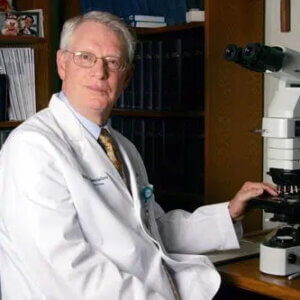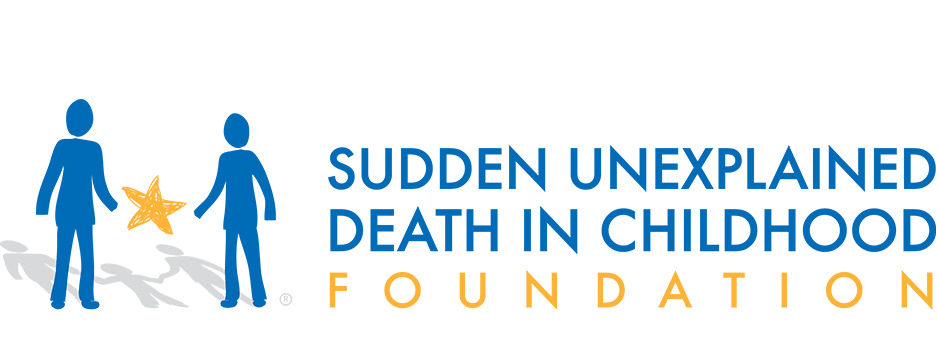23 Sep 20 Years of the SUDC Foundation: Catching Up with Dr. Henry Krous

20 years ago, Dr. Henry Krous gave a short presentation on a topic he knew very little about – sudden infant death after age 1 – and it ended up defining the latter part of his career as a pediatric pathologist. It was also during this presentation that he met former SUDC Foundation president Laura Gould, and the rest, as they say, is history.
Q: How did you get involved with the SUDC Program (the precursor to the SUDC Foundation)?
A: I was asked to give a talk at the National SIDS Conference in Atlanta on sudden infant death after age 1, and I got up and gave this presentation that was very short because I actually did not have much data on the topic. I made a few comments, and then it dawned on me. I looked at the audience – lots of parents and doctors and so forth – and asked, “Are there any of you who experienced the death of your child suddenly and unexpectedly after their first birthday?” And to my surprise, there were seven sets of parents who stood up. The one who was the most impressive, the most driven, was Laura Gould. And to this day, I have a tremendous amount of respect for her. Laura rose to the top in the SUDC world, which was nonexistent prior to her. I told her that I would very much appreciate the privilege of reviewing the medical records of the children [whose families had joined the SUDC Program] to see if I could find any common denominators and provide an analysis on what we could know. And at that point, Laura and I became a team.
Q: What was the extent of your involvement with the SUDC Program after that? How did you and Laura continue to work together?
A: I realized that [reviewing these children’s medical records] was going to require collaborators and expertise beyond my own, so I reached out to Hannah Kinney, a neuropathologist in Boston, and others, and started a collaborative network where my research program in San Diego became the repository for these cases.
The largest series of sudden death in toddlers ever reported prior to our work was only about five cases. It was just kind of mentioned in an article. As a result, as Laura and I continued to work together alongside my research team in San Diego, a very detailed questionnaire was developed that parents were asked to answer at their leisure. Because it was so long, and I’m sure it was extremely painful, they could take as long as they wanted to. In the meantime, the medical examiners around the country were extremely collaborative, and I was able then to get the reports – not only the autopsy, but the toxicology and other ancillary studies – and, with Laura’s help, we also managed to get permission to get hospital, clinic and physicians’ records, and we developed a database with many, many parameters.
And then with Laura, who is a co-author on the paper, I summarized the first 50 cases, which was immensely larger than anything that had ever been reported before. In that initial paper, we also provided the first definition of sudden unexplained death in childhood, or SUDC, as to distinguish that specifically from sudden unexpected death in childhood for which there are known causes. … We [also] identified for the first time a relationship to febrile seizures. I’ve spoken to pediatric neurologists across the country and many other countries, and the uniform reaction was, “Yes, they occur, and yes they are common, but they are never lethal.” And we found a very high incidence of febrile seizures, not only in the child that had died, but also in family members. And it occurred to us for the first time that maybe febrile seizures are not always benign, but that they precipitate a lethal event. And this was essentially followed up by work by Hannah Kinney, and we began to identify pathological findings within the hippocampus of the brain.
I think that when I retired, there were 163 cases in the database, mostly from the United States, but also from Canada, western Europe, Australia and New Zealand as well. So, I think it’s probably the most satisfying thing that I’ve done in my career, and it really boils down to a talk that I was asked to give, that I knew absolutely nothing about and that there was virtually nothing in the medical literature about. And now, we have the SUDC Foundation, we have research going on at different institutions looking into this, and a tremendous amount of progress has been made. There’s a lot of things that still need to be delineated and identified on why these toddlers, mainly toddlers, are dying without an explanation, but I think we’re getting closer to that every day.
Q: What is your background in the medical field, and how did your prior work translate into your work with the SUDC Program?
A: I did my training at the University of Washington, and sudden infant death syndrome was defined in a paper by Bruce Beckwith, and I was a fellow with Bruce Beckwith in pediatric pathology. Utter coincidence. I wasn’t even going to go into pathology, and when I met him, literally, I changed my career path at that moment. The baby of one of my intern mates had died, and died of SIDS, and that’s the first time I’d ever heard of SIDS and the first time I’d ever heard of pediatric pathology. For many years, I thought we were never going to understand this, and yet, after several decades, answers started to come forward with SIDS. The thing that I was really pleased about is that many of the approaches that we undertook with SIDS beginning in Seattle and then here in San Diego, I just applied them to the SUDC story, including trying to get a broad base of collaborators, and I think we really accelerated the information that we could get in SUDC at a more rapid rate than ever was acquired in SIDS itself. And I hope that that rate of knowledge and understanding continues.
Q: Describe your relationship with Laura.
A: Well, Laura is one of my heroes. You just simply cannot understate how important her role has been in this. I mean, she has shown the drive and the commitment, the intelligence, the persistence. I just cannot say enough about her because without her role, we wouldn’t be anywhere near where we are today. And Laura recruited parents. Like in the SIDS world, this could have never been accomplished without the role of parents, and Laura was the pioneer, the energy, the vision. She was incredible.
Q: Do you feel like you accomplished what you set out to do with regard to the SUDC Program and SUDC research specifically?
A: I do. And specifically what I mean by that is that with my retirement, and with Hannah Kinney’s essential retirement as well, this work has gone on. And one of the biggest concerns I had – and Hannah and I talked about this on many occasions – was when we retire, what’s going to happen to all of this? And I’m just so, so happy that the work continues to go on where people are pursuing this not only in the United States, but in other countries as well. So that has been exceedingly satisfying because I was really worried that we just would not find enough investigators who would be interested in pursuing this, and that’s just proven not to be true.
Q: When you look back at the last 20 years, what are you most proud of in relation to the SUDC Foundation?
A: It has been so satisfying to find something, or to help other people find something, that will explain the sudden death of their babies. I just cannot imagine anything worse happening to anybody than losing their baby for no apparent reason. And I think that with what has been gained by research and then disseminated to the public, we’ve seen dramatic declines in the rate of sudden infant death syndrome, and I think that we will see the same sorts of things when we have more and more understanding of SUDC.
I hate to use the word pride. I like to use the word satisfaction. It has been extremely satisfying to see something that came out of a presentation that I was totally mystified by. To see what it has evolved into today, where it has gone well beyond one person or two people, and one institution, to now many institutions in many countries. There’s a definition for it, and there’s far greater understanding of it.
Q: How do you feel about the current state of the SUDC Foundation and the work it is doing?
A: I think it’s terrific. I have to say, since I have retired, I am less involved in things, but I just cannot imagine that in the same way the research side has flourished, that the same thing isn’t going to continue on in the parent support, fundraising, and all the things that the SUDC Foundation has done so well for so many years. I’m very happy about what they have done, what they continue to do, and what I have no doubt will go on for a long, long time. And I hope that we don’t need an SUDC Foundation at some point, in the same way I hope we don’t need a SIDS Foundation at some point. We’ve got the means to predict and prevent this, and hopefully this will occur with infant and post-infant death alike.
Q: What do you hope is in store for the SUDC Foundation over the next 20 years?
A: I hope it’s able to maintain the level of fundraising, and keep this as a very visible and necessary program. Otherwise, I just don’t want to see the research end. It has to go on to answer these questions. Research is very expensive. At the same time, I think it’s critically important that parents are continued to be supported, the parents that lose their children, because it’s a lonely, mystifying, painful and – really, in so many ways – a never-ending ordeal.
I’ve had the sad fortune to speak to SIDS parents and SUDC parents for 30 or 40 years, and you know, my twin brother died suddenly and unexpectedly in 2000, and I don’t think I would ever equate the two, but it’s a hole in my heart that will never be filled. When people say something like, ‘Well, just have another baby.’ That’s completely the wrong thing to say. I encourage them to— Those babies are part of their family, and they should, in every way, keep them an important part of their family. Whether they add to their family or not. My heart goes out to them. I just can’t imagine anything worse.
We understandably feel that we are the protectors of our children, and parents so often, they think – appropriately – that they have done everything right, and so they have all this, “What I did I do wrong?” And the answer is they didn’t do anything wrong. You know, it’s easy to say that to somebody, but boy, it’s another thing to believe it.
Q: Anything else you want to share?
A: My work with the SUDC Program has easily been the most important and most satisfying part of my career. I’ve had a really wonderful career with a lot of endeavors – some disappointments, some successes – but this has been, without a doubt, the most satisfying thing that I have ever been involved in. Not only from an academic research side, but also from the humane side, feeling like I’ve participated in something that helped suffering families.


